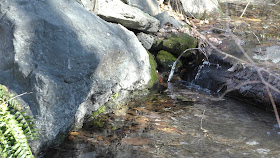I am on the look out for aquatic plants.
Here, you can see some green growing under the ice.
I could not break the ice to get a closer look on it.
The same land moss you see here grows nicely in my aquariums!
Ice is less thick on this stream.
Here I am able to pull out a cluster of filamentous algae from under the ice.
It comes with a red worm!
Put the catch in a bottle with water from the same stream.
Here, you see this sample of filamentous algae with the worm and the remains of some insect.
Samples of filamentous algae collected in the summer would come with different tiny critters.
I give them a chance with a pinch of homemade fish food.
January 27th, 2018
I am moving this red worm to another nursery, where I grow guppies and samples of filamentous algae collected in previous years.
A guppy male tries to eat the worm.
The worm is safe for now, hidden in a mesh of filamentous algae.
Filamentous algae is a natural safe house for many critters!
Also, filamentous algae is food for those critters and for many types of fish.
My guppies nibble on filamentous algae all day long.
I put the fresh winter sample on a windowsill for observation under a vigorous trusted guard.
The next day my watchful guard spotted intruders!
Those tiny moving white dots look like cyclopes!
I am going to keep them here for now.
February 8th, 2018
The population of cyclopes grows in the past week, while the amount of filamentous algae was reduced.
All types of algae need nutrition to grow.
Here, you see samples of filamentous algae collected at the same place 6 months earlier in August 2017.
The hair thin strings of filamentous algae grow in almost every freshwater lake and pond, among other type of algae.
The filamentous algae grows in these two aquariums since summer 2016.
Notice how it grows thinner and shorter in my aquariums than in the wild.
Take a closer look.
The wild grown filamentous algae is on the left.
The aquarium grown filamentous algae is on the right.
Here you see the same aquariums 3 weeks later.
Seed shrimps thrive in both nurseries.
Filamentous algae needs only sunlight and waste produced by aquatic creatures to double or triple its volume in a matter of weeks!
Check my self-sustaining aquarium video on how filamentous algae grows from one tiny string to take over an entire aquarium.
All types of algae are natural filters and food for fish and critters!
Control algae growth by reducing available nutrition and sunlight.
Check my previous video about algae control for more details.
Physically remove excess of filamentous algae as needed.
Have fun and happy aquarium :)
Here, you can see some green growing under the ice.
I could not break the ice to get a closer look on it.
The same land moss you see here grows nicely in my aquariums!
Ice is less thick on this stream.
Here I am able to pull out a cluster of filamentous algae from under the ice.
It comes with a red worm!
Put the catch in a bottle with water from the same stream.
Here, you see this sample of filamentous algae with the worm and the remains of some insect.
Samples of filamentous algae collected in the summer would come with different tiny critters.
I give them a chance with a pinch of homemade fish food.
January 27th, 2018
I am moving this red worm to another nursery, where I grow guppies and samples of filamentous algae collected in previous years.
A guppy male tries to eat the worm.
The worm is safe for now, hidden in a mesh of filamentous algae.
Filamentous algae is a natural safe house for many critters!
Also, filamentous algae is food for those critters and for many types of fish.
My guppies nibble on filamentous algae all day long.
I put the fresh winter sample on a windowsill for observation under a vigorous trusted guard.
The next day my watchful guard spotted intruders!
Those tiny moving white dots look like cyclopes!
I am going to keep them here for now.
February 8th, 2018
The population of cyclopes grows in the past week, while the amount of filamentous algae was reduced.
All types of algae need nutrition to grow.
Here, you see samples of filamentous algae collected at the same place 6 months earlier in August 2017.
The hair thin strings of filamentous algae grow in almost every freshwater lake and pond, among other type of algae.
The filamentous algae grows in these two aquariums since summer 2016.
Notice how it grows thinner and shorter in my aquariums than in the wild.
Take a closer look.
The wild grown filamentous algae is on the left.
The aquarium grown filamentous algae is on the right.
Here you see the same aquariums 3 weeks later.
Seed shrimps thrive in both nurseries.
Filamentous algae needs only sunlight and waste produced by aquatic creatures to double or triple its volume in a matter of weeks!
Check my self-sustaining aquarium video on how filamentous algae grows from one tiny string to take over an entire aquarium.
All types of algae are natural filters and food for fish and critters!
Control algae growth by reducing available nutrition and sunlight.
Check my previous video about algae control for more details.
Physically remove excess of filamentous algae as needed.
Have fun and happy aquarium :)


















































No comments:
Post a Comment